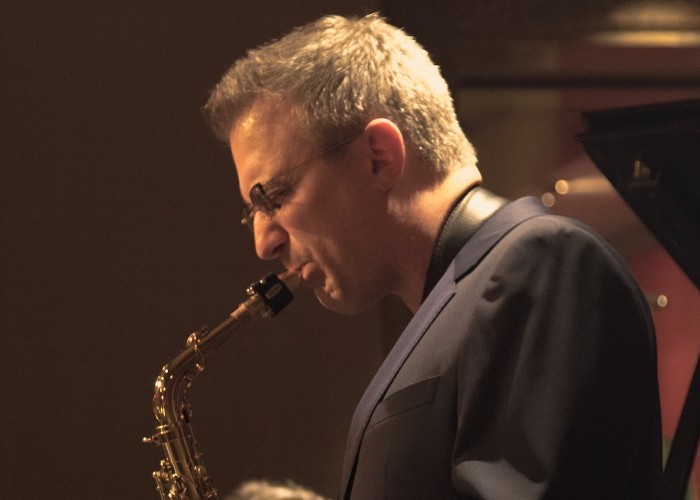Apr 2, 2024 12:59 PM
Saxophonist, Sonic Explorer Casey Benjamin Dies at 45
Casey Benjamin, the alto saxophonist, vocalist, keyboardist and producer who stamped his distinctive sounds on the…

Mike DiRubbo’s latest release is a live album recorded at Smalls in New York.
(Photo: Phil Blair)Performing at Smalls Jazz Club in New York this winter with the quartet of drummer George Coleman Jr., alto saxophonist Mike DiRubbo waited his turn as the players took solos on an uptempo Afro-Cuban composition. Guitarist Yotam Silberstein leapt out of the gate, spellbinding the well-watered crowd. Young bassist Eric Wheeler took an extraordinary solo, followed by pianist Brian Charette, who played sparse chords and adroit runs. When it came to DiRubbo’s solo, the 48-year-old Connecticut native simply played himself.
Something in DiRubbo’s tone, pacing and phrasing invites you to focus in and listen. It’s as if he has an internal reserve of wisdom and purpose, some burnished core of inner knowing.
DiRubbo’s ninth album, Live At Smalls (SmallsLive Records), shows the altoist performing his compositions with the quartet of Charette, bassist Ugonna Okegwo and drummer JK Kim. The quartet acquits itself well on DiRubbo’s material, but it’s the leader’s penetrating tone and intense delivery that draws you in.
Prior to earning his master’s in music from SUNY Purchase in 2017, DiRubbo studied with Jackie McLean at the University of Hartford’s Hartt School. While DiRubbo’s tone and touch owe little to the master alto player, his passion is a mainline connection.
“I definitely got that from being around Jackie,” DiRubbo says from his home on New York’s Upper East Side. “The first things you hear with Jackie are his sound, and you’re going to hear how his eighth notes fall in the meter. Jackie was my first real mentor, and he’s been the shining star the whole way, the thing to shoot for.”
DiRubbo’s sound best can be described as unhurried, focused, contemplative and oddly soothing.
“Mike has something that jazz musicians are striving for and continually working on—a recognizable sound,” says DiRubbo’s longtime collaborator Okegwo. “It’s a big part of his musical personality. His concept of improvisation is not just playing practiced patterns, but working on an idea with a direction in mind. He’s in the moment, telling a story, and it compels me to pay attention, to listen. Mike’s compositions have the same quality of having a clear direction, making his music purposeful.”
Currently teaching at Connecticut’s Sacred Heart University, DiRubbo encourages next-generation players to find their own voice.
“Even if you’re playing quiet or loud,” DiRubbo notes, “there has to be a certain way you get the horn to resonate. I try to tell students it’s how you get air into the horn, and a lot of it is how you think about it. The saxophonist is producing the sound; you can’t just walk up to it like a piano. That’s one of the frustrating things for people trying to learn how to play a wind instrument: You have to produce the sound, so it takes years to like what you hear.” DB

Benjamin possessed a fluid, round sound on the alto saxophone, and he was often most recognizable by the layers of electronic effects that he put onto the instrument.
Apr 2, 2024 12:59 PM
Casey Benjamin, the alto saxophonist, vocalist, keyboardist and producer who stamped his distinctive sounds on the…

“He’s constructing intelligent musical sentences that connect seamlessly, which is the most important part of linear playing,” Charles McPherson said of alto saxophonist Sonny Red.
Feb 27, 2024 1:40 PM
“I might not have felt this way 30 to 40 years ago, but I’ve reached a point where I can hear value in what people…

Albert “Tootie” Heath (1935–2024) followed in the tradition of drummer Kenny Clarke, his idol.
Apr 5, 2024 10:28 AM
Albert “Tootie” Heath, a drummer of impeccable taste and time who was the youngest of three jazz-legend brothers…

“Both of us are quite grounded in the craft, the tradition and the harmonic sense,” Rosenwinkel said of his experience playing with Allen. “Yet I felt we shared something mystical as well.”
Mar 12, 2024 11:42 AM
“There are a few musicians you hear where, as somebody once said, the molecules in the room change. Geri was one of…

Henry Threadgill performs with Zooid at Big Ears in Knoxville, Tennessee.
Apr 9, 2024 11:30 AM
Big Ears, the annual four-day music celebration that first took place in 2009 in Knoxville, Tennessee, could well be…